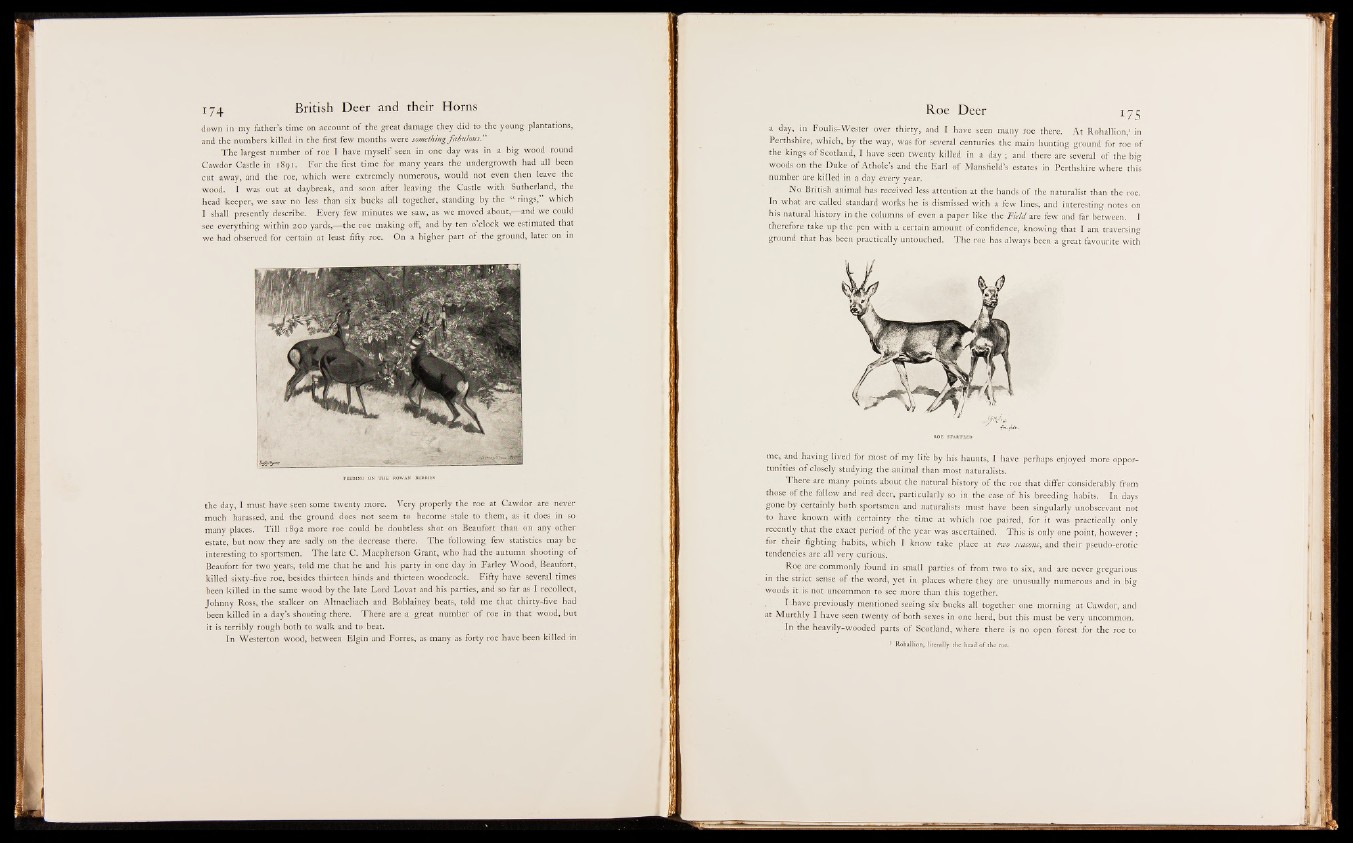
down in my father’s time on account o f the great damage they did to the young plantations,
and the numbers killed in the first few months were something fabulous.”
The largest number o f roe I have myself seen in one day was in a big wood round
Cawdor Castle in 1891. For the first time for many years the undergrowth had all been
cut away, and the roe, which were extremely numerous, would not even then leave the
wood. I was out at daybreak, and soon after leaving the Castle with Sutherland, the
head keeper, we saw no less than six bucks all together, standing by the “ rings,” which
I shall presently describe. Every few minutes we saw, as we moved about,— and we could
see everything within 200 yards,— the roe making off, and by ten o’clock we estimated that
we had observed for certain at least fifty roe. On a higher part o f the ground, later on in
FEEDING ON THE ROWAN BERRIES
the day, I must have seen some twenty more. Very properly the roe at Cawdor are never
much harassed, and the ground does not seem to become stale to them, as it does in so
many places. T ill 1892 more roe could be doubtless shot on Beaufort than on any other
estate, but now they are sadly on the decrease there. The following few statistics may be
interesting to sportsmen. The late C. Macpherson Grant, who had the autumn shooting o f
Beaufort for two years, told me that he and his party in one day in Farley Wood, Beaufort,
killed sixty-five roe, besides thirteen hinds and thirteen woodcock. Fifty have several times
been killed in the same wood by the late Lord Lovat and his parties, and so far as I recollect,
Johnny Ross, the stalker on Altnacliach and Boblainey beats, told me that thirty-five had
been killed in a day’s shooting there. There are a great number o f roe in that wood, but
it is terribly rough both to walk and to beat.
In Westerton wood, between Elgin and Forres, as many as forty roe have been killed in
a'J a y , to Foulis'-Wester over thtofy, and I have seen many roe there. A t Riohallion,1 in
Perthshire, which, fcy the way, was fer'jeveral centuries the main hunting groundtjor roe of
* e k ilf j j Scotland, I have s e g twenfje killed in a; day ; and there are several o f the big
w M i f a the Duke o f Athole’s and the E a r® ' Mansfieidls estates to Perthshire wbeie this
number are killed in a day every year.
No British animal has received less attention at the hands o f the naturalist than the roe.
In what are called standard works he is dismissed with a few lines, and interesting notes on
his natural history in the columns o f even a paper like the F ield are few and far between. I
therefore take up the pen with a certain amount o f confidence, knowing that I am traversing
ground that has been practically untouched. The roe has always been a great favourite with
me, and having lived for most o f my life by his haunts, I have perhaps enjoyed more opportunities
o f closely studying the animal than most naturalists.
There are many points about the natural history of the roe that differ considerably from
those o f the fallow and red deer, particularly $b in the case o f his breeding habits. In days
gone by certainly both sportsmen and naturalists must have been singularly unobservant not
to have known with certainty the time at which roe paired, for it was practically only
recently that the exact period o f the year was ascertained. This is only one point, however ;
for their fighting habits, which I know take place at two seasons, and their pseudo-erotic
tendencies are all very curious.
Roe are commonly found in small parties o f from two to six, and are never gregarious
in the strict sense o f the word, yet in places where they are unusually numerous and in big
woods i t . is not uncommon to see more than this together.
. I-.have .previously mentioned seeing six bucks all together one morning at Cawdor, and
at Alur.thly I have seen twenty o f both sexes in one herd, but this must be very uncommon.
In the heavily-wooded parts o f Scotland, where there is no open forest for the roe to
1 Rohallion, literally the head of the roe.
H
P 1
; li